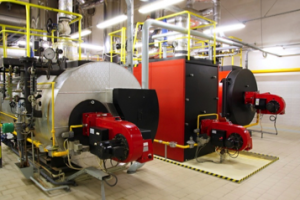
Boiler Reverse Osmosis
Boiler Feed Water Reverse Osmosis
Common water side impurities in boiler feed water cause a number of different operational issues for plant operations:
| ion | Limits Cycles of Concentration | Scale Forming Potential | Corrosion Causing Potential |
|---|---|---|---|
| Magnesium | Yes | Yes | Minor |
| Manganese | Yes | Yes | Minor |
| Iron | Yes | Yes | Minor |
| Silica | Yes | Yes | Minor |
| Alkalinity | Yes | Yes | Minor |
| Total Dissolved Solids | Yes | Yes | Yes |
| Total Dissolved Solids | Yes | Minor | Minor |
Traditional approaches to minimizing the impact of water impurities have included the operation of simple softeners and the addition of boiler water treatment chemicals. However, softeners only do a small fraction of the job as they are only designed to hardness ( calcium and magnesium ) and have little impact on the rest of the problem causing boiler feed water species such as alkalinity and silica.
Since softeners exchange sodium for hardness, and are regenerate with common salt ( a common brine used to regenerate a softener will contain 359,000 ppm salt ) , it is easy to see how much negative impact a softener can have on plant effluent EC ( Electrical Conductivity ) discharge limits. In addition the process is fairly inefficient as only the sodium portion of the sodium chloride regenerant is used.
Finally softeners use a significant amount of water ( up to 10% of all flow put through the softener ) in the regeneration processes of backwash, brining, slow rinse and fast rinse.
| ion | Impact of Sodium Softener |
|---|---|
| Calcium | Large |
| Magnesium | Large |
| Manganese | Small |
| Iron | Small |
| Silica | None |
| Alkalinity | None |
| Total Dissolved solids | Raises Slightly |
In the boiler operating environment, alkalinity changes from carbonate and bicarbonate to hydroxide and CO2. While some hydroxide is needed in the boiler to prevent corrosion – Often, there is too much alkalinity in the boiler feed water; which results in too much alkalinity in the boiler, which limits cycles of concentration. Thus, boiler fuel is wasted, and increases the chance for unwanted boiler foaming and carry over. All CO2 formation in the boiler environment is unwanted as CO2 is a gas that departs the boiler for the steam system, and finally enters the condensate forming carbonic acid. The more CO2 potential you have, the higher the potential for carbonic acid in the condensate system. Softeners do nothing to reduce CO2 potential as softeners do not alter boiler feed water alkalinity.
Silica is a cycles limiting factor in the boiler. The more silica present in the boiler feed water, the lower the boiler cycles of concentration must be to avoid scaling. Running a boiler at cycles of concentration lower than could be the case results in significant waste of boiler make up water and more importantly fuel.
| Cycles | Steam HP | Condensate Return | Pounds Lbs Feed H2O Needed | Pounds Condensate Returned | Blow Down | Feed Water Needed | Make Up Water Needed |
|---|---|---|---|---|---|---|---|
| 10 | 500 | 50% | 414,000 | 207,000 | 41,400 | 455,400 | 248,400 |
| 100 | 500 | 50% | 414,000 | 207,000 | 4,140 | 418,140 | 211,140 |
| Annual Feed H2O Pounds Savings Potential | 13,599,900 | ||||||
| Annual Feed H2O Gallons Savings Potential | 1,630,683.45 | ||||||
Use of Reverse Osmosis to treat boiler feed water will result in a reduction of over 98% of all ionic boiler water impurities.
Benefits associated with use of Reverse Osmosis include:
Reverse Osmosis in place of softening will reduce boiler fuel use costs
Reverse Osmosis in place of softening will reduce boiler water use and costs
Reverse Osmosis in place of softening will reduce plant effluent EC – Electrical Conductivity
Reverse Osmosis in place of softening will reduce boiler chemical treatment costs
Reverse Osmosis in place of softening will reduce boiler condensate system corrosion potential
